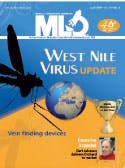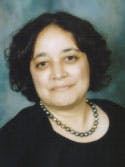Letters to the editor
Readers respond
A day in the life …
Editor's note: The editorial office
at MLO is never a dull place. Near the end of January, we
received a telephone call from Ralph Henson in San Francisco, who asked
a simple question: When and where was the term “point-of-care testing”
coined? At one time, said Mr. Henson, today's POCT was known as “bedside
testing” or “near-patient testing.” He thought it might be one of our
supplements, however, in one of his many last “good deeds,” Dan Baer,
MD, our “Tips” editor, suggested that I contact Peter Howanitz, MD, who,
he believed, had been very active in this area through CAP.
Dr. Howanitz wrote back in response to our e-mail: “I
do not know who coined the term point-of-care testing. At one time, the CAP
coined and used the name 'alternate-site testing,' which others changed to
'alternative-site testing' for these tests. The term POCT had been used long
before this testing started with glucose meters in hospitals in 1979.
Perhaps Dr. Baer may reflect on the ward labs that many medical centers had
for their residents and medical students where urines and hematocrits were
done. This practice started long before my time or Dr. Baer's time.”
Then Dr. Baer chimed in: “I think I found the answer
to Ralph Henson's question about POCT. Gerald Kost's book, Principles and
Practice of Point of Care Testing, begins with a brief history of POCT
(page 3). Table 1 lists a chronology of guidelines and standards. There is a
1993 paper by Dr. Kost using the term POCT. This is the first use I see in
the literature. On page three of the book, Kost writes, “Point of care is
testing at or near the site of patient care. After more than 10 years of
descriptive use, this term was codified when a group of multidisciplinary
physicians, professionals, and leaders met at the national meeting of the
Society of Critical Care Medicine in 1994 and selected this phrase and
definition from competing alternatives. Later, representatives from this
group and co-authors published a clarifying position paper.” [From “The
Laboratory-Clinical Interface” by P. Zaloga, R. Phillip Dellinger, Terry
Shirey, Gerald J. Kost, Sharon S. Ehrmeyer, Bart Chernow, and James W.
Winkelman in Chest 999;115;1140-1154.]
When we told Mr. Henson of our “discoveries,” he sent
a message: “Thanks for the update. I am very certain that the three MLO
supplements which were sponsored by Mallinckrodt Sensor Systems were
published within a period covering 1991 and 1992. The first reference that I
can find for point-of-care testing is the MLO supplement to the
September 1991 issue called 'MLO Special Issue: Point-of-Care
Testing,' which was sponsored by Maillinkrodt Sensor Systems, according to
four different 'find articles.com' links.
Mallinkrodt Sensor Systems may well have been the
first company to market its products using the term 'point-of-care testing;'
and if my memory serves, the term was coined in about 1989 or 1990 by then
product manager for Gem Systems, Ms. Cindy Flinn, who was trying to
differentiate the Gem 'near-patient' blood gas/electrolyte analyzer from the
ubiquitous 'bedside' glucometers. I seem to recall an evolution from
'testing at the point of healthcare delivery' to 'point-of-care testing'
during that period of time — but I do not have any hard documentation to
support that belief.”
On this, our 40th MLO birthday, perhaps
someone in
MLO ReaderLand can help us pinpoint more information that would
clarify POCT. We welcome your comments.
Peeling away misconception
This short case presentation certainly did a good job of highlighting the
various causes of hyperkalemia. However, I wanted to take this opportunity
to 'peel' away a common misconception regarding bananas and potassium. The
foods highest in potassium are generally dried fruits, dates, juices, beans,
trail mix, etc.1 The potassium in prepared foods and fast foods
can be, like sodium, way above the range found in natural food sources.
Bananas are much lower, so why do they commonly get the bad 'wrap' for
contributing to hyperkalemia? Generally speaking, unless there is some
mental problem or renal disease, people do not get hyperkalemia from dietary
sources.2,3,4 Hyperkalemia is much more likely to be caused by
disease and iatrogenic causes before natural food sources. Additionally,
when advice is given to eat bananas for repleting lost potassium from renal
losses (tubular disease, diuretics, etc.) or vomiting/NG suction, it is good
to remember that most dietary sources of potassium are coupled with
phosphates. The blood level of potassium will not normalize until the
chloride is restored.5
—Douglas E. Eglen, MD
Department of Pathology
Howard Regional Health System
Kokomo, IN
References
- USDA National Agricultural Library. Available from
http://www.nal.usda.gov/fnic/foodcomp/Data/SR20/nutrlist/sr20a306.pdf
. Accessed April 23, 2009. - Berk DR, Conti PM, Sommer BR. Orange juice induced hykperkalemia in
schizophrenia. IJPM. 2004;34(1):79-82. - Tazoe M, Narita M, Sakuta R. Hykperkalemia and hyperdopaminemia
induced by obsessive eating of banana in an anorexia nervosa adolescent.
Brain Dev. 2007;29(6):369-72. - Hall JB, Schmidt GA, Wood DH, eds. Principles of Critical Care. 2nd
ed. New York, NY: McGraw Hill;1998:1174. - Gennari FJ. Hypokalemia. NEJM 1998,339 (7):451-458.
Condolences
I am stunned and very saddened by the news that Dr.
Daniel Baer has passed away. As a long time MLO subscriber and very
old tech, I look forward to the MLO “Tips” articles every month — it
is the first thing I read. I tear them out, file, and save them. Several
times, at the request of our facility's management, I posed questions to Dr.
Baer. He always answered (with references). He was, is, and will remain both
a credit to his profession and a national treasure. My deepest sympathy to
his family and friends. Thank you.
—Nancy Kovacs, MT(ASCP)
Curtice, OH
Dr. Baer leaves a legacy that we laboratorians can
look up to! My condolences to his family and close friends.
—BJ Holscher, (CLS), MT(ASCP)
Lincoln,
CA
May I add my tribute to Dan. He was a generous man
with much to give, and he gave it to us all. Thanks, Dan.
—Joe Keffer, MD
Past President, ASCP
Hello, Dr. Karon: I just read of Dr. Baer's passing
in an e-mail where it said he was selecting you to carry on his column for
MLO. Early on my career as a medical technologist with Mayo Medical
Laboratories, I took a class from Dr. Baer in Chicago and always felt a
connection to him and has column — his practicality. I had read the March
MLO article where he was guest editor and thought it sounded like a
good-bye column — as a matter of fact, I still have the magazine on my desk
open to that column, pondering if that was his last. It's nice to hear he
had selected you to continue on. Congratulations! (One thought I had with
every magazine release was, “Well, if he's still working, I guess I should
be, too!”)
—Jeanenne Wilcox
Resource Bid Specialist
Mayo Medical Laboratories
Rochester, MN
Editor's note:All condolences from MLO readers will
be relayed at their request to Dr. Baer's family. Write to
[email protected] or to
[email protected] .
The winner is…
Winners of Executive War College Scholarships 2009
Christine was awarded with paid tuition, travel, and
hotel expenses to attend the 2009 Executive War College on Lab and Pathology
Management in New Orleans, April 28-29, 2009. Marianne received tuition and
hotel expenses for the two-day conference.
Christine Tillman of Chula Vista, CA, has been a
technologist since 1975, and is currently the blood bank lead and quality
coordinator at Sharp Grossmont Hospital in San Diego. She is the lab
representative for the SCRUBBS program, which fosters high school students'
interest in a career in laboratory science. Christine also participates in
the Labs Are Vital campaign, and promotes the laboratory science field as a
bureau speaker, television spokesperson, and judge for school science fairs.
Marianne Gehen of Angola, NY, has been a medical
technologist since 1982, and is currently lab manager of pathology and
laboratory services at Buffalo General Hospital and DeGraff Memorial
Hospital in New York. She is the corporate laboratory-safety officer and
leads the laboratory-safety committee. She is also the clinical coordinator
for student programs.
The Executive War College on Laboratory and Pathology
program is designed to help laboratory administrators and pathologists learn
practical methods for improving the organizational performance and financial
success of their laboratories.



